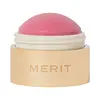Merit Beauty The Minimalist Perfecting Complexion Foundation and Concealer Stick Versus Merit Beauty Flush Balm
What's inside
What's inside
 Key Ingredients
Key Ingredients

 Benefits
Benefits

 Concerns
Concerns

 Ingredients Side-by-side
Ingredients Side-by-side

Hydrogenated Polydecene
EmollientCaprylic/Capric Triglyceride
MaskingOctyldodecanol
EmollientSilica
AbrasiveSynthetic Wax
AbrasiveDipentaerythrityl Hexahydroxystearate/Hexastearate/Hexarosinate
Skin ConditioningHydrogenated Polyisobutene
EmollientCopernicia Cerifera Wax
Triethoxycaprylylsilane
Cera Microcristallina
Emulsion StabilisingSorbitan Isostearate
EmulsifyingMica
Cosmetic ColorantAluminum Hydroxide
Emollient1,2-Hexanediol
Skin ConditioningStearalkonium Hectorite
Gel FormingTocopheryl Acetate
AntioxidantCaprylyl Glycol
EmollientDimethicone
EmollientPropylene Carbonate
SolventEthylhexylglycerin
Skin ConditioningGlycerin
HumectantWater
Skin ConditioningTocopherol
AntioxidantPancratium Maritimum Extract
BleachingCI 77891
Cosmetic ColorantCI 77491
Cosmetic ColorantCI 77492
Cosmetic ColorantCI 77499
Cosmetic ColorantHydrogenated Polydecene, Caprylic/Capric Triglyceride, Octyldodecanol, Silica, Synthetic Wax, Dipentaerythrityl Hexahydroxystearate/Hexastearate/Hexarosinate, Hydrogenated Polyisobutene, Copernicia Cerifera Wax, Triethoxycaprylylsilane, Cera Microcristallina, Sorbitan Isostearate, Mica, Aluminum Hydroxide, 1,2-Hexanediol, Stearalkonium Hectorite, Tocopheryl Acetate, Caprylyl Glycol, Dimethicone, Propylene Carbonate, Ethylhexylglycerin, Glycerin, Water, Tocopherol, Pancratium Maritimum Extract, CI 77891, CI 77491, CI 77492, CI 77499
Octyldodecanol
EmollientHydrogenated Polyisobutene
EmollientHydrogenated Poly(C6-14 Olefin)
EmollientPolyethylene
AbrasiveSilica
AbrasiveDiisostearyl Malate
EmollientSynthetic Wax
AbrasiveSynthetic Fluorphlogopite
Sorbitan Isostearate
EmulsifyingEthylene/Propylene Copolymer
AbrasiveCera Microcristallina
Emulsion StabilisingTocopherol
AntioxidantMethicone
EmollientTriethoxycaprylylsilane
BHT
AntioxidantCI 77891
Cosmetic ColorantCI 77492
Cosmetic ColorantCI 15850
Cosmetic ColorantCI 19140
Cosmetic ColorantOctyldodecanol, Hydrogenated Polyisobutene, Hydrogenated Poly(C6-14 Olefin), Polyethylene, Silica, Diisostearyl Malate, Synthetic Wax, Synthetic Fluorphlogopite, Sorbitan Isostearate, Ethylene/Propylene Copolymer, Cera Microcristallina, Tocopherol, Methicone, Triethoxycaprylylsilane, BHT, CI 77891, CI 77492, CI 15850, CI 19140
 Reviews
Reviews

Ingredients Explained
These ingredients are found in both products.
Ingredients higher up in an ingredient list are typically present in a larger amount.
Cera Microcristallina isn't fungal acne safe.
Ci 77492 is also hydrated iron III oxide. It's sole purpose is to give a yellow hue to products.
Iron III oxides are classified as inorganic chemicals for coloring.
Synthetically created Ci 77492 is considered safer than those naturally found. This is because the synthetically created version may contain less impurities. Iron oxides are generally non-toxic and non-allergenic.
Learn more about CI 77492Ci 77891 is a white pigment from Titanium dioxide. It is naturally found in minerals such as rutile and ilmenite.
It's main function is to add a white color to cosmetics. It can also be mixed with other colors to create different shades.
Ci 77891 is commonly found in sunscreens due to its ability to block UV rays.
Learn more about CI 77891Hydrogenated Polyisobutene is a synthetic polymer. Polymers are compounds with high molecular weight. Hydrogenated Polyisobutene is an emollient and texture enhancer.
In one study, Hydrogenated Polyisobutene showed better skin hydration levels than Caprylic/Capric Triglyceride. As an emollient, it helps keep your skin soft and hydrated by trapping moisture in.
Hydrogenated Polyisobutene is often used as a mineral oil replacement.
Learn more about Hydrogenated PolyisobuteneOctyldodecanol is a fatty alcohol. It is primarily used to enhance the texture of products.
As an emulsifier, Octyldodecanol helps prevent the oils and waters from separating. It also prevents ingredients from creating foam when shaken.
Octyldodecanol is created by reducing fatty acid to an alcohol.
Due to its high molecular weight, it does not get absorbed into the skin.
Learn more about OctyldodecanolSilica, also known as silicon dioxide, is a naturally occurring mineral. It is used as a fine, spherical, and porous powder in cosmetics.
Though it has exfoliant properties, the function of silica varies depending on the product.
The unique structure of silica enhances the spreadability and adds smoothness, making it a great texture enhancer.
It is also used as an active carrier, emulsifier, and mattifier due to its ability to absorb excess oil.
In some products, tiny microneedles called spicules are made from silica or hydrolyzed sponge. When you rub them in, they lightly polish away dead skin layers and enhance the penetration of active ingredients.
Learn more about SilicaSorbitan Isostearate is an emulsifer and cleaning agent. It is created from isostearic acid and sorbitol.
As an emulsifier, Sorbitan Isostearate prevents oils and water from separating.
Due to its isostearic acid base, it may not be safe for Malassezia or fungal acne.
Learn more about Sorbitan IsostearateSynthetic Wax is created from fossil fuels such as natural gas. It is used to enhance texture, adjust pH, and as an occlusive.
It may also be used as an abrasive ingredient to exfoliate the skin.
Synthetic Wax may not be fungal acne safe.
Learn more about Synthetic WaxTocopherol (also known as Vitamin E) is a common antioxidant used to help protect the skin from free-radicals and strengthen the skin barrier. It's also fat soluble - this means our skin is great at absorbing it.
Vitamin E also helps keep your natural skin lipids healthy. Your lipid skin barrier naturally consists of lipids, ceramides, and fatty acids. Vitamin E offers extra protection for your skin’s lipid barrier, keeping your skin healthy and nourished.
Another benefit is a bit of UV protection. Vitamin E helps reduce the damage caused by UVB rays. (It should not replace your sunscreen). Combining it with Vitamin C can decrease sunburned cells and hyperpigmentation after UV exposure.
You might have noticed Vitamin E + C often paired together. This is because it is great at stabilizing Vitamin C. Using the two together helps increase the effectiveness of both ingredients.
There are often claims that Vitamin E can reduce/prevent scarring, but these claims haven't been confirmed by scientific research.
Learn more about TocopherolTriethoxycaprylylsilane is a silicone used to bind and stabilize ingredients.
As an emulsifier, it helps prevent ingredients from separating. This can help elongate the shelf life of products.
Triethoxycaprylylsilane is often used to coat mineral sunscreens ingredients to help give a better feel. It also helps reduce oxidative stress in sunscreens.
Learn more about Triethoxycaprylylsilane